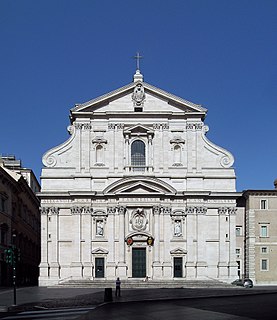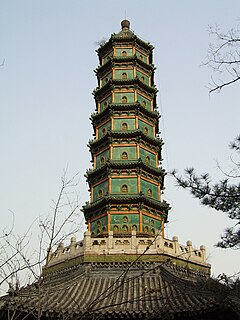
The year 1780 in architecture involved some significant events.

The Palazzo Barberini is a 17th-century palace in Rome, facing the Piazza Barberini in Rione Trevi. Today it houses the Galleria Nazionale d'Arte Antica, the main national collection of older paintings in Rome.

The Villa Marlia or Villa Reale di Marlia — a late-renaissance palazzo or villa, and its estate's property that includes renowned gardens and adjacent villas and follies within the compound. It is located in Capannori, in the Province of Lucca, west of Florence, in the northern Tuscany region of Italy.

Villa Garzoni at Collodi is a villa just over the border of the province of Lucca,. The garden was built shortly before 1652 by the Garzoni family, relating to the site of the old castle, which stands slightly apart, closely associated with the village that nestles round it, on the edge of a clifflike slope, which had been chosen in earlier times for its defensible approach. The garden of Villa Garzoni, whose layout "makes the fullest use of a precipitous hillside site in a manner that is usually associated with Rome", features giochi d'aqua, or a water garden, constructed at the foot of a series of balustraded terraces and a suite of grand symmetrical staircases connecting the lower water gardens at the base of the hill, with the house, the cascade, the teatro di verdura and other garden features above. At each terrace level, side walk past fantastically clipped yew blend imperceptibly with the wooded slope. Its cascade, which the exigencies of the site prevented from alignment with the main axis, has been called one of two "culminating High Baroque statements" of the trends toward drama and spectacle. The garden designers of Potsdam, Fontainebleau, and Versailles had influences from these gardens and has earned its fame across the European continent.
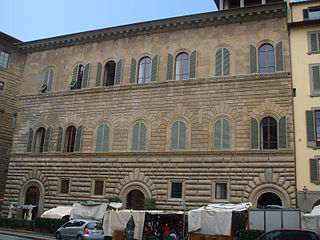
Palazzo Gondi is a palace in Florence, Italy, located a block from Piazza della Signoria. It was built in 1490 under design by Giuliano da Sangallo, who was inspired by other major works of stately buildings in the city, such as Palazzo Medici and Palazzo Strozzi. Among the elements borrowed from these earlier works are the cube-shape set around a central courtyard, the ashlar sloping on each of three floors, and the arched windows.

Palazzo Castiglioni is an Art Nouveau palace of Milan, northern Italy. It was designed by Giuseppe Sommaruga and built between 1901 and 1903. The rusticated blocks of the basement imitate a natural rocky shape, while the rest of the decorations are inspired by 18th century stuccos. The building is now used as the seat of the Unione Commercianti di Milano.

The Ducal Palace is a palace in Lucca, Tuscany, central Italy.
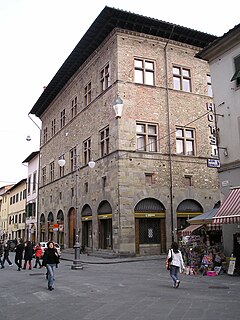
Palazzo Panciatichi or Palazzo del Balì is a medieval aristocratic palace located on Via Camillo Benso Cavour #35 in Pistoia, Tuscany, Italy. It a block away from the Palazzo Fioravanti.

The Palazzo delle Poste is located in Piazza Matteotti in central Naples. It is an example of architecture completed during the fascist government of Benito Mussolini. Another such example is the nearby Palazzo della Casa del Mutilato and the adjacent Palazzo della Questura on via Medina. Just north and across the street on via Monteoliveto is the 16th-century Palazzo Orsini di Gravina.

The Palazzo Orsini di Gravina is a Renaissance-style palace on number 3 Via Monteoliveto, in the San Lorenzo quarter of Rione San Giuseppe-Carità, of central Naples, Italy. Since 1940, it has housed the Faculty of Architecture of the University of Naples. It is located across the street and a few doors north of the sleek and modern Palazzo delle Poste. Across the street at the north end of the palace, is the Piazza Monteoliveto with its Fountain and the church of Sant'Anna dei Lombardi.

The Palazzo Zevallos Stigliano is a Baroque palace located on Via Toledo number 185 in the quartiere San Ferdinando of central Naples, Italy. It is also called the Palazzo Zevallos or Palazzo Colonna di Stigliano, and since 2014 serves as a museum of artworks, mainly spanning the 17th through the early 20th centuries, sponsored by the Cultural Project of the bank Intesa Sanpaolo. This museum is linked to the Museum or Gallerie di Piazza Scala in Milan and the Museum at Palazzo Leoni Montanari in Vicenza, also owned by the Bank.

The Museo Nazionale di Villa Guinigi is the main art museum hosting the pre-modern art collections owned by the city of Lucca, Italy.

The Museo Nazionale di Palazzo Mansi is one of the two main art museum hosting tapestry collections and mainly post-19th century art collections owned by the city of Lucca, Italy. The collection is displayed in the Baroque palace, formerly belonging to the Mansi family, and located in central Lucca. Many of the original room decorations remain in place.
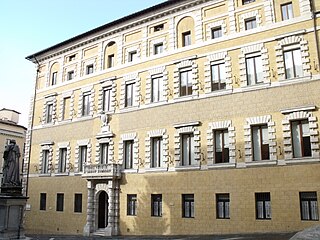
The Palazzo Tantucci is a Renaissance style urban palace localized on Via dei Montanini, on the Piazza Salimbeni, in the Terzo di Camollia, in the city of Siena, region of Tuscany, Italy. To the palace's right is the Gothic facade of the Palazzo Salimbeni, and across the Piazza with Sallustio Bandini's statue is the Classic Renaissance facade of the Palazzo Spannocchi. All three palaces are owned now by the Monte dei Paschi di Siena, one of the oldest banks in Europe, which arose in the Salimbeni palace.

The Casino Mediceo di San Marco is a late-Renaissance or Mannerist style palace located on Via Cavour number 57 and via San Gallo in Florence, region of Tuscany, Italy.
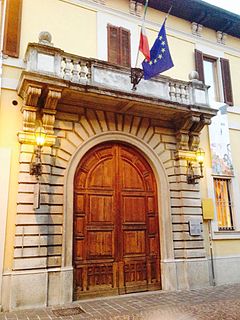
The Palazzo Ghirlanda-Silva is a patrician building in the old town of Brugherio, Italy. Built in the first half of the nineteenth century, it now houses the public library. It has an area of 1,992 m2 (21,440 sq ft), of which 1,407 m2 (15,140 sq ft) are used for library services, with the remaining space providing an exhibition room, an auditorium and offices.
The Palazzo Bernardini is a Renaissance palace located on the Piazza Bernardini, diagonal from the church of San Benedetto in Gotella in central Lucca, region of Tuscany, Italy.
The Palazzo Cenami is a Renaissance-style palace located on Via Santa Croce in central Lucca, region of Tuscany, Italy. The palace was designed in 1530 by Nicolao Civitali. Some attribute the palace's Florentine style of architecture to Agostino Marti in 1501.

The Palazzo Lanfranchi-Toscanelli, presently the local State Archives, is a Renaissance-style palace located on Lungarno Mediceo #30, in the city of Pisa, region of Tuscany, Italy. Since 1913 the building has housed the Archivio di Stato di Pisa.
The Palazzo Lanfranchi is a palace located on Lungarno Galileo Galilei #8, in the city of Pisa, region of Tuscany, Italy.




